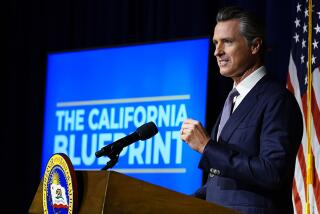Wilson Budget Reflects Rising State Economy
SACRAMENTO — Benefiting from swelling state coffers, Gov. Pete Wilson unveiled his proposed $66.6-billion state budget Thursday, detailing plans to cut welfare, boost education spending and give businesses and banks a new tax cut.
Calling for some of the most significant welfare changes in a generation, Wilson is proposing to go even further than required by recent federal law in overhauling a system he says has failed.
Among other things, the governor wants to force people off welfare rolls and into jobs, while combating teenage pregnancies and trying to ensure that fathers take responsibility for their children.
“We must end a welfare system that undermines the work ethic, that trapped generations in dependency,” Wilson said as he released his seventh state budget.
In the budget for the next fiscal year starting July 1, Wilson would trim the cost of the main welfare program for families from $5.1 billion to $4.6 billion, reflecting in part a 15% reduction in monthly welfare checks and a smaller number of people receiving aid.
At the same time, the governor is offering an array of programs to help needy families find work: $80 million for one employment program and $53 million so community colleges can train welfare recipients for jobs, plus a $9.4-million increase for child care starting when a baby is 12 weeks old and grants for minor car repairs deemed necessary for recipients to reach their new jobs.
The governor called welfare overhaul the most important challenge facing the state. If he and the Legislature fail to reach an accord, Wilson said, the state not only will face federal penalties but “will miss the opportunity to really reform a system that is failing a great many people.”
As he proposed historic changes in welfare, Wilson offered a significant boost for education spending.
Under his plan, the state would spend an average of $5,010 a year per public school pupil, with the total from all sources reaching $5,989 per student by the end of the next fiscal year in 1998.
Among his more far-reaching education proposals, Wilson is calling for $1.26 billion to fund a popular program to lower class size to 20 students in kindergarten through third grade. The state is spending $771 million to lower class sizes this year.
The governor’s school spending proposal complies with requirements of Proposition 98. Approved by voters in 1988, Proposition 98 requires that the state spend roughly 60 cents of every new dollar of tax revenue on local schools. In all, public schools will receive nearly $21 billion, a $1.9-billion jump from last year.
California’s colleges and universities will receive $6.5 billion, and for the third consecutive year fees will not be increased at California’s public universities and colleges.
The total spending plan of $66.6 billion represents a 4% increase from the current budget. The state’s General Fund, which pays for most state programs and is filled primarily by state income and sales taxes, will be $50.3 billion, an increase of 4.7%. The reserve for emergencies is $553 million.
The governor’s budget is a far different document than it was during the recession, when he was forced to propose cuts in many programs and faced tough fights in the Legislature. This year, legislative leaders were less than strident in their criticism of Wilson’s overall spending proposal.
“As a rule, the governor wins 90% of the fights,” Senate President Pro Tem Bill Lockyer (D-Hayward) said.
“The governor’s budget is a common sense approach to the issues of welfare reform, improving education and encouraging job creation and economic growth,” said Assembly GOP Leader Curt Pringle (R-Garden Grove). “It’s fair but firm.”
Assembly Speaker Cruz Bustamante (D-Fresno) appeared supportive of much of the governor’s welfare blueprint.
“Nobody disagrees with [moving] people into jobs,” Bustamante said. “And I think we’re going to move forward on the welfare issue.”
But many Democrats questioned Wilson’s rigid time limits for ending welfare grants, such as the one-year cap for new recipients. Following federal law, the state would impose a five-year lifetime limit on receiving benefits.
“All you have is welfare abdication. You don’t have reform,” said Assemblyman Antonio Villaraigosa (D-Los Angeles). “We have to transition 1 million people now on welfare into jobs in . . . two years if the governor has his way. The real issue is, where is the money going to come from?”
With the debate just beginning, Republicans were urging bridge-building.
“The Democrats are already declaring war when we haven’t even come to the table yet to discuss it,” said Assemblywoman Marilyn Brewer (R-Newport Beach). “That doesn’t serve the people in this state. You have to have a broader picture, because what we set in place is going into live on for a number of years.”
In his new budget, Wilson has scrapped his proposal to cut state personal income taxes, something he championed for two years but failed to get through the Legislature. But while he is offering no overall tax cut, the governor once again is proposing to cut taxes on the profits of banks and corporations.
Wilson’s budget calls for a two-year, 10% cut in California’s bank and corporate taxes. The new tax rate would be 7.96%. Banks and corporations received a 5% tax cut starting Jan. 1.
The tax cuts, if approved by the Legislature, would be worth $150 million in 1997-98. That sum would grow to $600 million by 1999.
Wilson’s budget envisions that California’s economy will continue to expand, generating 330,000 new jobs in 1997 and 1998. As more people find work and pay taxes, revenue to the state will grow.
Wilson’s proposal is a first step--and one that is sure to change as negotiations continue between the governor and legislators.
The shape of the budget becomes more firm in May, after taxpayers pay their income taxes and the Department of Finance updates its estimate of revenue available for various programs.
The Legislature, which must approve the document by a two-thirds vote, will open hearings on the budget next month, going through the two-inch-thick document line by line.
By law, the state must have a new budget in place by the July 1 start of the fiscal year. If the past is any gauge, serious negotiations do not begin until the middle of that month. Last year, the budget was not signed into law until July 15.
Orange County officials said they were still examining the budget Thursday evening and could not say exactly how it will affect the county’s finances.
“There are some positives from what we’ve seen thus far,” said county spokeswoman Diane Thomas. “But we’ve just begun to review it.”
Officials are most concerned about welfare reform, which threatens to force the county to dramatically increase funding for general relief as recipients become ineligible for other types of welfare.
Another pressing issue is trial courts funding. County officials are hoping that the state agrees to pay for a greater share of court operations. This year, the county courts have a shortfall of $42 million and will shut down in May if more money isn’t found.
Some specifics in the budget:
Taxes
Although there are no general tax increases, the governor is asking for an increase in some fees at the Department of Motor Vehicles totaling $50 million.
Education
Wilson is proposing a ballot measure asking voters to approve a $2-billion bond for new classrooms and construction.
Wilson is proposing salary increases at the UC and state university system.
Prisons
Altogether, the budget for adult and youth prisons will be $4.3 billion, an increase of almost 6%. The budget includes funds to hire 587 people for a new prison at Corcoran in the Central Valley that would house drug abusers.
Wilson is asking the Legislature to approve $334 million in bonds to help build two prisons.
Health and Welfare
In Wilson’s proposed budget, the cost of providing health care and welfare benefits to the poorest Californians is $14.6 billion.
With new cuts in effect as of Jan. 1, a welfare family of three now receives $565 a month in urban counties, and $538 a month in some rural counties. The governor proposes to cut that check 15% after six months if the recipient has not found a job.
The governor proposes to spend $113 million to combat teenage pregnancy and increase spending on funding for childhood immunization by $15.3 million.
Wilson’s budget envisions completing the closure of Camarillo State Hospital, which houses 160 mentally ill people and had housed 450 mentally retarded people. The move will save the state $69 million and cut nearly 1,500 jobs.
Environment
Wilson proposes to spend $700 million from the general fund on environmental programs.
The budget proposal calls on the state parks department to charge more for park concessions and to impose fees on school groups.
* ADOPTION: Call for welfare recipients to give up children is assailed. A3
* EDUCATION: Some worry that 4% increase won’t go very far. A3
More to Read
Get the L.A. Times Politics newsletter
Deeply reported insights into legislation, politics and policy from Sacramento, Washington and beyond. In your inbox three times per week.
You may occasionally receive promotional content from the Los Angeles Times.










